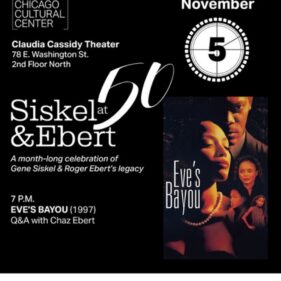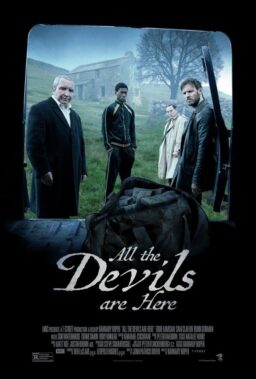In “Roger’s Favorites,” we highlight the filmmakers and actors that Roger championed throughout his career. A table of contents for all of our “Roger’s Favorites” posts can be found here. Below is an entry on directors Kasi Lemmons, Patty Jenkins and Kimberly Peirce.
Few film debuts ever impacted Roger like “Eve’s Bayou” (1997), which announced the arrival of Kasi Lemmons—best known for playing Jodie Foster’s roommate in “The Silence of the Lambs” (1991)— as a major filmmaker. In his interview with Lemmons, Roger wrote that her film sees its central characters, a troubled Southern family, “not in the relaxed, everyday way of ‘Soul Food’ but in the forms of classic family tragedies by Bergman, Chekhov and Eugene O'Neill.” He gave the film four stars in his official review, in which he revealed that he saw the film three times, and that if it wasn’t nominated for Academy Awards, it would be because “the Academy is not paying attention. For the viewer, it is a reminder that sometimes films can venture into the realms of poetry and dreams.” He also felt that Lemmons’ achievement was “a rebuke to established filmmakers,” considering that she made a film this good on her first try.
The following year, Roger wrote an article in response to pundits who claimed that the box office failure of “Beloved” (1998), starring Oprah Winfrey, was proof that audiences will not support “a serious film on black themes.” He reminded the pundits that “Eve’s Bayou” was the top-grossing American independent film of 1997, and was “a serious film without a single white character. It outgrossed all those independent films about young white guys on the make, sitting around in diners and smoking cigars.”
Lemmons’ next film, “A Caveman’s Valentine” (2001), earned three stars from Roger, and featured “the most unexpected sex scene” he had seen while covering Sundance that year. In his review, he wrote that the film’s schizophrenic lead character was one of actor Samuel L. Jackson’s “most intriguing creations,” and that Lemmons succeeded again in “fleshing out” her story, though he felt the film was less interesting as a murder mystery.
More to Roger’s liking was Lemmons’ third feature, “Talk to Me” (2007), a biopic of radio personality Ralph “Petey” Greene, played by Don Cheadle in “a fascinating performance.” He especially admired how the film portrayed Greene’s “finest moment,” in which he went on the air the morning after Rev. Martin Luther King, Jr.’s assassination. “This unexpected angle on the King assassination, focusing on the pain of the living, is handled by Lemmons with deep feeling,” Roger wrote in his three-and-a-half star review. “She takes an event of enormous, almost incomprehensible tragedy, and focuses it on Petey Greene’s personal transformation.”
Roger didn’t know who the lead actress was in Patty Jenkins’ “Monster” until he saw her name in the end credits. “I didn’t recognize her —but more to the point, I hardly tried, because the performance is so focused and intense that it becomes a fact of life,” Roger wrote. In his four-star review, he said that Jenkins had “made the best film of the year,” and that Charlize Theron had delivered “one of the greatest performances in the history of the cinema.” He also saw the film as “an exercise in the theological virtue of charity,” in how it avoids exploitation in its humanistic portrayal of a damaged soul.
When he officially named “Monster” as the best film of 2003, Roger wrote that Theron gave the “the performance of the year in the film of the year.” Theron went on to win a multitude of accolades, including the Oscar for Best Actress. When Jenkins won the Independent Spirit Award for Best First feature, she saw Roger across the room, and spent the bulk of her speech thanking him for championing smaller films in need of recognition. Her words inspired the room to give Roger a standing ovation. In a remembrance written after his death, Jenkins reflected on the impact of Roger’s review on her career. “Roger saw completely what I was trying to do and reflected it back to me in words; he saw things that even people who were working with me didn’t see: that this film was an education in the human experience, letting you walk in the shoes of someone who is technically the worst kind of monster so that you can see how a person ends up in that situation,” Jenkins wrote.
Another example of Roger hailing a first-time filmmaker occurred in 1999, when Kimberly Peirce made her debut with another fact-based drama, “Boys Don’t Cry.” In his four-star review, Roger acknowledged that the film “could have gone wrong in countless ways,” but Peirce found “the right note” for the material, never cranking “the story above the level it’s comfortable with.” He was so absorbed by the film on first viewing that it was only afterward that he realized how it served as “a worthy companion to other masterpieces of death on the prairie, ‘Badlands’ and ‘In Cold Blood.’”
In his Top Ten list for 1999, “Boy’s Don’t Cry” ranked at #4. Roger cited that the film contained two of the year’s best performances from leading ladies Hilary Swank and Chloe Sevigny, both of whom went on to earn Oscar nominations that year (Swank took home the Best Actress trophy). “Kimberly Peirce‘s movie helps us understand the motives behind gay-bashing and murder, crimes that feed on ignorance and low self-esteem, often fueled by drugs and booze,” Roger wrote.











